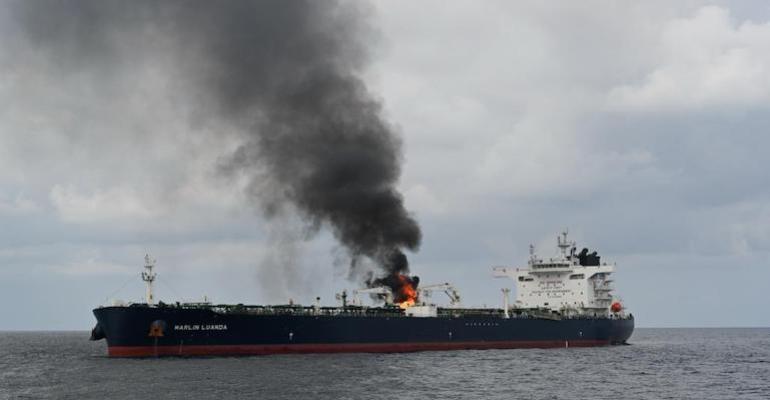In the three months since the Red Sea disruptions began the situation appears to be heading into a more intense and broadening confrontation with seafarers, on the vessels that still operate in the Red Sea, more at risk now than when the Houthi Movement first announced its aggressive policy.
Dryad Global CEO Corey Ranslem believes that “It has been an interesting weekend.” Though the news that “the RubyMar bulker sank,” will have dampened spirits Ranslem said at least “the crew are reported as being safe,” adding “This is the first vessel that has sunk as a result of a Houthi attack”.
Acknowledging the targeting of ships Xenata chief Analyst Peter Sand separates the conflict into two parts, “the exchange of fire and the disruption to global supply chains.”
In the first instance, the “exchange of fire” has seen no re-establishment of the safe passage through the Red Sea and Suez route, while the shift of trade from Suez to the longer Cape route appears to have been completed, albeit at a higher rate level.
Houthi leaders vowed to target ships heading to Israel or whose owners support Israeli actions against Gazan Palestinians. Action by the Houthi military has seen commercial vessels divert around the African Cape, adding 10 days or so to a typical Asia to Europe journey.
In response to Houthi attacks the US and its allies, mainly the UK, have targeted Houthi missile launch capabilities, with little apparent effect on preventing attacks.
This weekend alone, Houthi spokesman Yahya Sare’e claimed that Yemeni forces had hit two UK-owned vessels, including the Rubymar and Pollux and to have downed a US MQ9 Predator drone.
Meanwhile, even as the Houthi missiles were heading for British operated vessels, the US Central Command was reporting its successes in protecting commercial vessels.
“Between the hours of 3:00pm to 8:00pm (Sanaa time), Feb. 17, CENTCOM successfully conducted five self-defence strikes against three mobile anti-ship cruise missiles, one unmanned underwater vessel (UUV), and one unmanned surface vessel (USV) in Iranian-backed Houthi-controlled areas of Yemen,” reported CENTCOM on X.
Perhaps of more concern was that CENTCOM also reported that this marked an escalation of Houthi capabilities with the US military noting: “This is the first observed Houthi employment of a UUV since attacks began in Oct. 23.”
Notwithstanding this weekend’s events Ranslem argues: “At this point it appears that the [allied] military operation has been effective to some degree as we’ve seen the number of attacks against ships drop significantly over the past few weeks. However, there is still a significant threat in this region against commercial shipping.”
As such Ranslem voices his surprise that vessel operators are continuing to “risk” crew, ships and cargo in this region.
Dryad Global is sceptical of the need for dialogue with the Houthi Movement as a means to resolving the conflict: "I don’t know how effective negotiating with the Houthi’s and Iranians would be at this point as this is not financially motivated, but motivated by the events in Gaza. I would believe there are some back-channel negotiations that are taking place through other indirect third parties as that is usually the case in these situations.”
As a result of the limited scope for conflict resolution Sand noted: “There is no prospect of re-establishing a safe passage through the Red Sea around the corner.”
That means for the foreseeable future container ships will maintain the new longer routes, which have effectively, “dealt with the crisis for trade” explained Sand, though at a higher rate level.
“In October Asia to Europe rates were around $1,000/feu, now they have settled around the $4,000 mark, but the uncertainty in the trade has been calmed,” said Sand.
That increase in logistics costs will have an effect on lower cost goods, which have smaller margins, but the higher end goods will be able to absorb these extra costs, said Sand.
“The impact on inflation from these increases will be there, but this should not be over-stated,” said Sand, “It’s not like a year ago, there will be no major impact on inflation.”
It is difficult to ignore the ongoing humanitarian tragedy in Gaza and Israel, however, the impact on shipping has been limited, so far, to some minor damage, though perhaps not to the RubyMar if its loss is confirmed, and some seafarers currently held hostage on the hijacked Galaxy Leader.
Trade has also seen a limited impact from the war. And in this sense, at least, perhaps the logistics situation in the Middle East could be categorised as ‘could be worse’.
While such a view is not the “captivating beauty of the Red Sea, where each wave carries the promise of a sustainable tomorrow,” as suggested by Saudi Arabia’s Red Sea authority this week, it has seen an alleviation of the immediate economic tensions in western democracies.
But for an enduring and stable trade route the ongoing political and military conflict must also be resolved in a positive and just manner. And that should be an attraction for all involved.
Copyright © 2024. All rights reserved. Seatrade, a trading name of Informa Markets (UK) Limited.
Add Seatrade Maritime News to your Google News feed.  |

